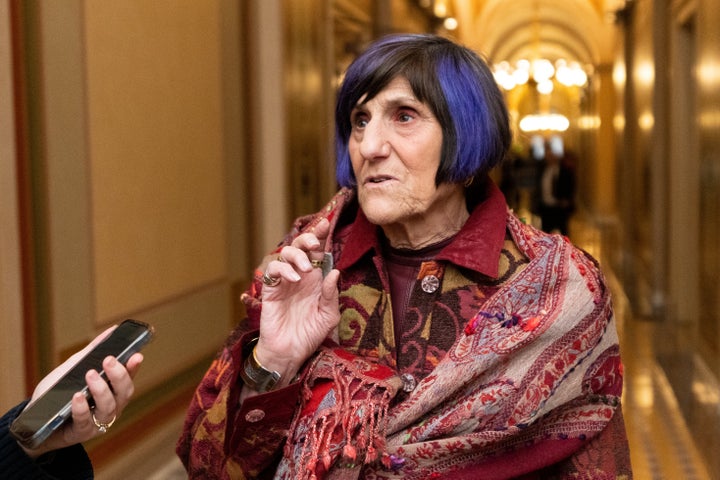Debt limit dealmakers face a central dilemma that will be hard to finesse: finding spending levels for next year that allow Republicans to claim they cut spending and, at the same, allow Democrats to say they did not.
As the talks have dragged on, the divide has come into sharper focus.
House Speaker Kevin McCarthy (R-Calif.) has castigated Democrats for not being able to find a penny to cut, while Democrats have said the size of cuts in the $4.8 trillion GOP debt limit bill make them politically untenable and point to this week’s postponement of committee meetings on the annual bills that fund most federal agencies as proof.
Rep. Tom Cole (R-Okla.), a longtime member of the House Appropriations Committee that doles out the annual funding in question, told HuffPost a final bill will need not only bipartisan support, but a minimum level of support within each party in order for a deal to work.
“There’s a political calculation here as to what does each side need to turn to votes on the board to feel secure that they don’t look like they were selling out their side,” he said.
But that will be hard to achieve given the glaring gulf between the positions. The bill House Republicans barely pushed through in April would set a spending cap for the next budget year, which starts Oct. 1, at $1.471 trillion, the same total that applied for 2022.
For the current year, agencies are working off of a $1.498 trillion pot of money.
“I don’t think I’m asking the impossible. Let’s spend less in the coming year than we spent this year,” McCarthy said Wednesday in an interview on Fox Business Network.
“There’s a political calculation here as to what does each side need to turn to votes on the board to feel secure that they don’t look like they were selling out their side.”
- Rep. Tom Cole (R-Okla.)
Democrats have balked at going backward. But they have left open the idea of freezing spending at the current level, but no lower.
“It’s reasonable for all sides to consider a common ground, middle-of-the-road position, which is to freeze spending at the 2023 level,” House Democratic Leader Hakeem Jeffries (D-N.Y.) said Wednesday.
“It’s not everything that Democrats want, but it is a middle ground position, which President Biden has offered to House Republicans.”
If spending were capped at either level and frozen, or allowed to only grow slowly over several years, as in the House Republican bill, the potential cuts would be large. But finding a way to reconcile the GOP’s below-current-level and Democratic not-below-current-level spending positions will be tough.
Cole, though, said there’s “some wiggle room” between the two seemingly incompatible positions.
“We’re acting as if the budget is the only spending that’s going on around here,” Cole said, referring to the appropriations process. But appropriations make up only about one-third of overall spending by the government, thanks to big entitlement programs like Social Security and Medicare.
Also, extra spending is often provided on an emergency basis, not counting against an annual cap. And Democrats used a budget process called reconciliation to add money last year.
“The reality is the reconciliation bills were huge. So spending’s going to come down, it’s going to be lower than what it was last year, regardless,” Cole said.
“Our own people, frankly, I think sometimes don’t recognize that and recognize that you’ve already cut spending. And thank goodness you have.”

In the past, annual budget caps were often renegotiated as lawmakers later decided they were too restrictive. That’s what happened with the 2011 Budget Control Act, which was touted when passed as cutting spending by more than $2 trillion but saw about $800 billion in cuts reversed over its 10 years.
Rep. Chip Roy (R-Texas) said that experience meant lawmakers needed to lock in as much savings as possible early.
“That’s the whole point of getting near-term restraint on spending,” he said.
Even if both sides agree on a number, they will still have to agree on how to divide that spending amount between defense and domestic priorities. Typically, appropriations subcommittees meet around this time each year to start the process, which includes voting on amounts and amendments.
But those meetings were postponed this week, leading Democrats to say Republicans like cuts in the abstract but are afraid to vote for the non-defense spending levels needed to protect the Pentagon from cuts.
“They are unraveling,” said Rep. Rosa DeLauro (D-Conn.), the top Democrat on the House Appropriations Committee.
Rep. Debbie Wasserman Schultz (D-Fla.) noted the markup for one of the most bipartisan bills each year, for military construction and veterans programs, was delayed.
“That bill’s markup was canceled, along with the rest of them, because the Republicans didn’t have the votes,” she said.
Cole downplayed the significance of the postponed markups, saying it was due to the uncertainty of what final spending number may emerge.
“We didn’t want to do anything that might inadvertently undercut the speaker’s negotiation,” he said.
Wasserman Schultz, though, said Republicans’ vehement reaction to the accusation that their plan will require steep non-defense cuts just shows that Democrats are right.
“They are protesting like stuck pigs,” she said.
